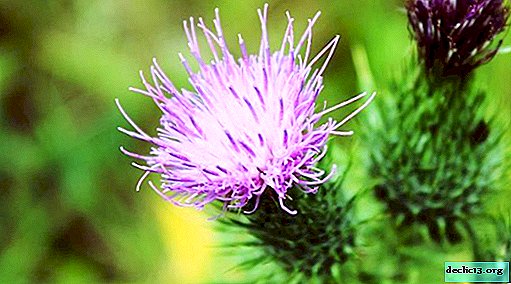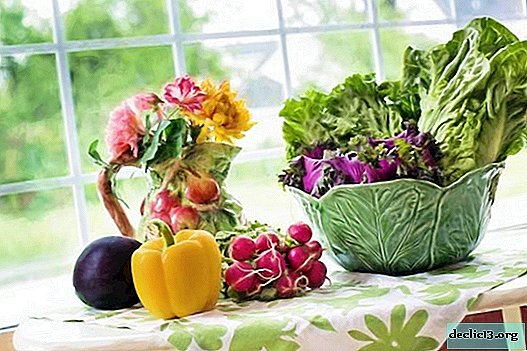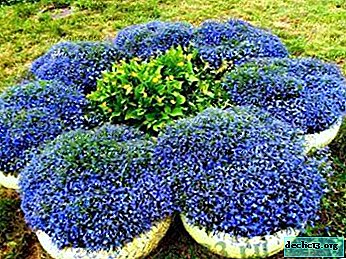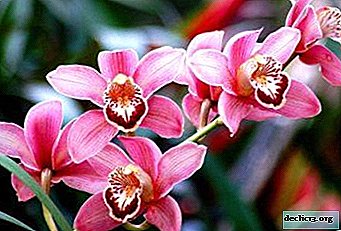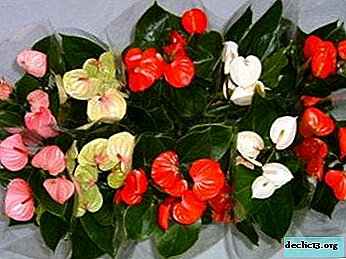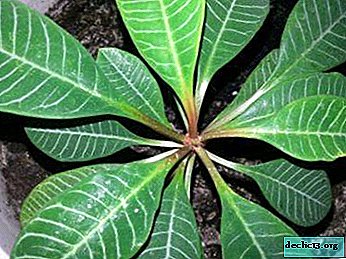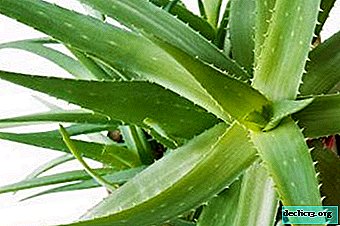Useful and tasty "white carrot" - parsnip: description, application, growing a vegetable
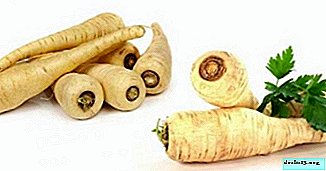 Parsnip (“white carrot”) belongs to the vegetable crop, the Umbrella family. Appreciated for its spicy taste, beneficial properties, nutrients, used in folk medicine.
Parsnip (“white carrot”) belongs to the vegetable crop, the Umbrella family. Appreciated for its spicy taste, beneficial properties, nutrients, used in folk medicine.
This article describes in detail what this culture is, what features it has, and how to grow it in its suburban area.
Characteristic
Definition
Parsnip is a vegetable from the celery family with a thick sweetish root crop. Refers to perennial herbaceous plants with fleshy root of the genus Pastinaca. The culture is compared to ordinary carrots, due to the similar appearance and growth characteristics.
What are the other names?
The people call the vegetable a white root, a clerk, field borsch, tragus. In European territory, 15 species of parsnip are growing. Here is a list of the most popular:
- Armenian (Pastinaca armena).
- Sowing (meadow, ordinary) (Pastinaca sativa).
- Shadow (Pastinaca umbrosa).
- Klaus (Pastinaca clausii).
- Forest (Pastinaca sylvestris).
- Thigh-leaved (Pastinaca pimpinellifolia).
The culture got its name because of the place of growth, characteristics, appearance, useful properties.
Parsnip Klaus is very rare, single plants. The main habitat is the territory of the Bogucharsky district. Unlike other species, this root crop significantly reduces its number.What does it look like?
The herbaceous plant with a sharp-ribbed erect pubescent and rough stem has a fleshy beige root. Parsnip branches at the very top, reaches a height of 1 to 2 m. In its appearance, the vegetable resembles carrots and parsley.
Botanical Description
Parsnip is a two-year-old Umbrella plant. It is easy to recognize by its stem, leaves, flowers, root crop.
Structure
 The following factors will help you better understand the structure of parsnip:
The following factors will help you better understand the structure of parsnip:
- Stem. Tall, erect. It has a strong branching at the apex. Paired with leaves forms a tall bush with medium width.
- Leaves. Large, pinnate, with pointed ends. The color is bright green. The top surface of the plate is smooth, and the bottom is rough.
- Flowers Appear in August in the second year after the appearance of sprouts. Small, bisexual, collected in umbrellas from 5-15 rays. The calyx is slightly expressed, the corolla is colored yellow.
- Seeds Ripen in September. Two seedlings are flat, round-elliptical.
- Root. Roundedly oblate, conical with a gradual decrease to the base. It can be conical with a sharp narrowing. Different lengths - 8-15 cm, 15-25 cm, more than 25 cm. Weight - up to 100 g, 100-200 g, over 200 g. Weight and length depends on the variety. The pulp is white.
Parsnip has a specific aroma and spicy taste. Ripe vegetables are also called "white root".
Root crop is of nutritional value. Gardeners claim that it has a sweetish flavor and a pleasant aroma. High tastes are perfectly visible in the prepared dishes.Biological features
The plant is actively grown as a forage and vegetable crop. Beekeepers especially appreciate the flowering parsnip as a very productive honey plant. The honey obtained is of high quality, has a light pleasant color.
How and where is it found in nature?
Europe, the Caucasus, Asia Minor - the natural habitat of parsnip. It is less common in the North Caucasus, the south of the European part, in Western Siberia. It grows in the form of thickets of bushes or in solitary specimens.
The difference between the leaves and roots of the clerk and parsley
The main difference is in parsnip leaves. They are not suitable for eating due to stiffness, unpleasant taste. They can cause an upset stomach and irritation of the digestive system. Parsley root is rarely eaten. According to many people, it has no value and benefit.
History of origin and country of origin
Culture has existed for more than several thousand years. The first to grow it were the Peruvian Indians from the Quechua tribe. Then there was a variety of "Arakach" or "Peruvian carrots." The first mention was found in the works of pundits from Ancient Rome, Dioscorides and Pliny. In Russia, they learned about parsnip in the 17th century, but it gained its main popularity in the 18th century.
Chemical composition
The root crop is rich in useful substances. Mineral salts, carbohydrates, B vitamins (1, 2, 3) are present in the greatest amount. Essential oils give the vegetable a special smell: they contain odorous octibutyl butyric acid ester.
 Nutritional value per 100 g of product:
Nutritional value per 100 g of product:
- calorie content - 47 kcal;
- proteins - 1, 4 g;
- fats - 0, 5;
- carbohydrates - 9, 2 g;
- dietary fiber - 4.5 g;
- organic acids - 0.1 g;
- ash - 1, 3 g;
- water - 83, 0 g.
The ripe fruits of the Parsnip inoculum or its other species include coumarins and flavonoid glycosides. Furocoumarins are presented:
- xanthotoxin:
- bergapten;
- sphondin and polyine.
Benefit and harm
Regular consumption of parsnip in food will allow you to experience the following changes in the body:
- increase immunity;
- improving body tone;
- lack of cough, pain in the gastrointestinal tract, kidneys and liver;
- elimination of toxins;
- a decrease in blood sugar in diabetes;
- improvement of mental performance;
- in men - increased potency;
- in women - elimination of inflammation in the pelvic area.
Pregnant women can safely eat fresh root vegetables. They will minimize the risks of developing edema, osteoporosis and anemia.
There are no contraindications to the use of parsnip. However, experts recommend nursing mothers to consult with their doctor first. There is a risk of allergic reactions to essential oils or any other components that make up the composition.
Caution is not prevented when in contact with wet leaves of the plant. Especially for people with light sensitive skin. Greens leaves burns on the skin, which heals for a very long time.
Treatment with this root crop
 The plant is actively practiced in folk and official medicine. The resulting infusions and decoctions will help get rid of drowsiness, apathy, loss of strength, edema, nervousness, colds. Parsnip is used as:
The plant is actively practiced in folk and official medicine. The resulting infusions and decoctions will help get rid of drowsiness, apathy, loss of strength, edema, nervousness, colds. Parsnip is used as:
- anesthetic and diuretic broth, or a means to strengthen the strength of seriously ill people;
- alcohol tincture that increases appetite and mood;
- medicine in the form of "Beroxan", "Eupiglin" and furocumalin pastinacin.
Modern people rarely resort to the help of the vegetable in question in the treatment of various ailments. But the above beneficial properties and components of the chemical composition proved that parsnip is a real miracle of nature.
Varieties and types: description with photo
The appearance depends on the shape of the rhizome. Exist:
- Long Parsnip. Features - elongated root crop, grows only on light fertile soils.
- Round parsnip. Features - the root crop has a rounded shape, unpretentious to growing conditions.
Each species includes several unique varieties. To choose the most suitable, you should pay attention to frost resistance, soil type, region of residence, ripening period.
So for the middle zone, Siberia and the Urals, it is recommended to choose a parsnip with early ripening, which perfectly withstands prolonged frosts and adverse weather conditions.
Popular varieties of round parsnip:
- Delicacy. Features - early ripening, suitability for long-term storage. The mass of rhizomes is 200-350 g, length is 8 cm. The flesh is yellow-white.
- Round. Fast ripening, flattened-rounded fruits with white-gray flesh. Weight - 170 g.
- Russian size. Frost resistance, long roots - up to 30 cm, pungent smell, sweet-pleasant taste, fruits are rounded elongated.
Popular varieties of long parsnip:
- Harris modal. Maturing term - 4 months. Forms fruits up to 30 cm, having a shade of ivory. The pulp is white, tender, with a delicious taste.
- Petrik. Mid-early variety with a growing season of 80 to 130 days. It has dietary properties, forms rhizomes up to 35 cm long. The flesh is grayish-white, with a pleasant aroma, juicy and very tasty.
- Student. High-yielding variety with late ripening. It is not afraid of prolonged drought, forms white root crops with a length of up to 30 cm and a weight of 160 g. The pulp is tasty, scaly, snow-white.
Photo of parsnip varieties.
Delicacy:

Round:

Russian size:

Harris Modal:

Petrik:

Student:

Where to get the seed?
You can buy seeds in any specialized store or order online. The starting price of one package in Moscow is 15 rubles, and in St. Petersburg - 10 rubles. The price depends on the variety.
Landing
It is better for gardeners from regions with a warm climate to sow directly in open ground in March or April. Pre-soak the seeds in growth regulators. Follow manufacturer's recommendations. If this is an area with a cold climate, then use the seedling method. In this case, seed germination is performed in late April or early May.
The instruction is as follows:
- planting material placed in a humid environment for 14 days;
- then quench in the refrigerator for 2-3 hours;
- to land in temporary containers;
- after 2-3 weeks, thin out the sprouts, leaving only strong specimens;
- after 30 days, repeat the thinning procedure.
After you can start landing in the open ground. Planting pattern - hole depth - 30 cm, width - 40 cm, distance between plants - 40-50 cm. After planting, water abundantly.
Gardening
Parsnip is a plant unpretentious to care. It is recommended to exclude frequent watering. Monitor the moisture level of the soil. Fertilizing make at will, it is better at the flowering stage.
Hilling will save the aerial part of the rhizomes. The procedure will eliminate their damage from sunlight. Weeding will be a preventive measure against many infections and pests.If the care of the plants was decent, then the gardener will receive from 20 to 30 tons of root crops per 1 ha.
We offer you to watch a video about the features of growing parsnip:
Harvesting and storage
Harvest dates depend on the variety: either at the end of July or at the beginning of September. Produce root crops carefully. It is better to arm yourself with a pitchfork. After harvesting, dry the vegetables. To fill in boxes with sand. Place a basement or cellar in a cool, dry room with a temperature of 0 to + 4 ° C.
How to give a plant to children?
 It’s good to give the child a culture, especially at the age of one. Today there are special products in the form of mashed potatoes for the first feeding. Before use, it is recommended to take into account the manufacturer's advice indicated on the package.
It’s good to give the child a culture, especially at the age of one. Today there are special products in the form of mashed potatoes for the first feeding. Before use, it is recommended to take into account the manufacturer's advice indicated on the package.
Parsnip will help older children:
- improve mental performance;
- to concentrate attention;
- boost immunity.
Give vegetables fresh or heat-treated, twice a week.
How to replace?
Turnips, carrots, parsley root are the best substitutes for parsnip. They belong to the same family. They have similar taste qualities, chemical composition and useful properties.
Parsnip is a healthy and tasty vegetable. Everyone can grow it, regardless of region of residence, experience in the field of agricultural technology. The main thing is not to forget to take into account the recommendations of manufacturers, the main nuances of planting and subsequent care, harvesting and storage of crops.

